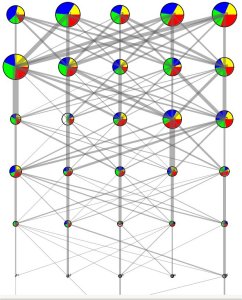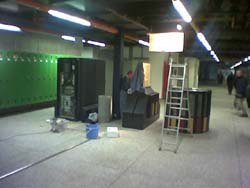Strategy Bob's Funky Outputs
Posted: February 27th, 2004 | No Comments »Funky unexpected outputs while developing StrategyBob a strategy visualizer. When wrong algorithms meet random values…
![]()

Funky unexpected outputs while developing StrategyBob a strategy visualizer. When wrong algorithms meet random values…
![]()

We put online and roughly commented some of the map visualizations we made at the CRAFT as part of the researches on mobile technology in a formal learning environment and exploring spatial features for collaborative problem solving with locative media.
Pascal took some of his valuable time to explain me his use of Hibernate and xDoclet:
i use hibernate as an ORM tool. it is the bridge between my Objects and relational DB (mysql). it offers persistence for objects, as long as these objects are following some simple rules (getters, setters, … actualy you just need to write them Bean style).
hibernate creates the tables, the SQL statements (DB system dependent…just tell it you use oracle…and it will create oracle compliant SQL….at deploy time). hibernate also takes care of IDs, polymorphism and so on. just tell it to persist an object….bumm. its stored (i just signed up for my marketing career at hibernate ![]() )
)
for hibernate to know the relations, properties, …, you need to feed it with mapping files (*.hbm.xml). writing these files by hand is a pain. thats where xDoclet comes at rescue….just add some hibernate tags to your java comments and generate everything. magic.
java source code (note the @hibernate tags in the comments):
Read the rest of this entry »
Lyon en mouvement avec sa cité internationale (palais des congres, interpol, hilton, casino, musee d’art contemporain).

Mot clé surpise du week-end: Gollnisch.
An heating technician from Central Services maintaning a Cray supercomputer in the Information Retrieval building.

Thomas Allen of MIT is considered on e of the progenitors of modern office design. In a ten-year study of engineering in R&D labs, Allen found that proximity matters: People interact most with those located close to them; people seated more than seventy-five feet apart rarely interact at all. Other studies found that software developers, like many creative workers, need both interaction and intense, focused concentration. When people had the “flow” of their creative work interrupted, it typically took them 20 to 30 minutes to refocus. Source: Creative Class.
A few terms from Nicolas Nova‘s Locative Media: a literature review:
Awarness: the understanding of other’s person’s interaction with a shared workspace.
The awarness tool: The lack of information about the geographically-dispersed partners is addressed by providing users with tools that try to “recreate the information landscape of a real-world landscape
Locative media: every information about the physical location as well as other contextual cues. It can be decomposed into three awarness components: presence, location and direction.
Read the rest of this entry »
Because a university contains the 3T’s of creative places – technology, talent and tolerance.
Technology: Universities are centers for cutting-edge research in fields from sotware to biotechnology and important sources of new technologies.
Talent: Universities are amazingly effective talent attractors.
Tolerance: Universities aslo help to create a progressive, open and tolerant people climate that helps attract and retain members of the Creative Class.
As creativity has come to be valued and systems have evolved to encourage and harness it, a new social class is rising. The so-called Creative Class as defined by Richard Florida in his book The Rise of the Creative Class. I skipped the part on the Creative Economy, but I was more interested in the social definition of the members of the Creative Class. A few notes:
The core of the Creative Class include people in science and engineering, architecture and design, education, arts, music and entertainment, whose economic function is to create new ideas, new technologies and/or new creative content.
Read the rest of this entry »
The Koala XML serialization provides an easy way to serialize and deserialize any Java Objets in an XML document. This application is called KOML for Koala Object Markup Language. To be used next time I want my Java serialized object to be interoperable with other application, like in the Portalvisualizer where my Java visualization that created and used serialized objects could have interoperate with the PHP/SVG visualization developped by Patrick.